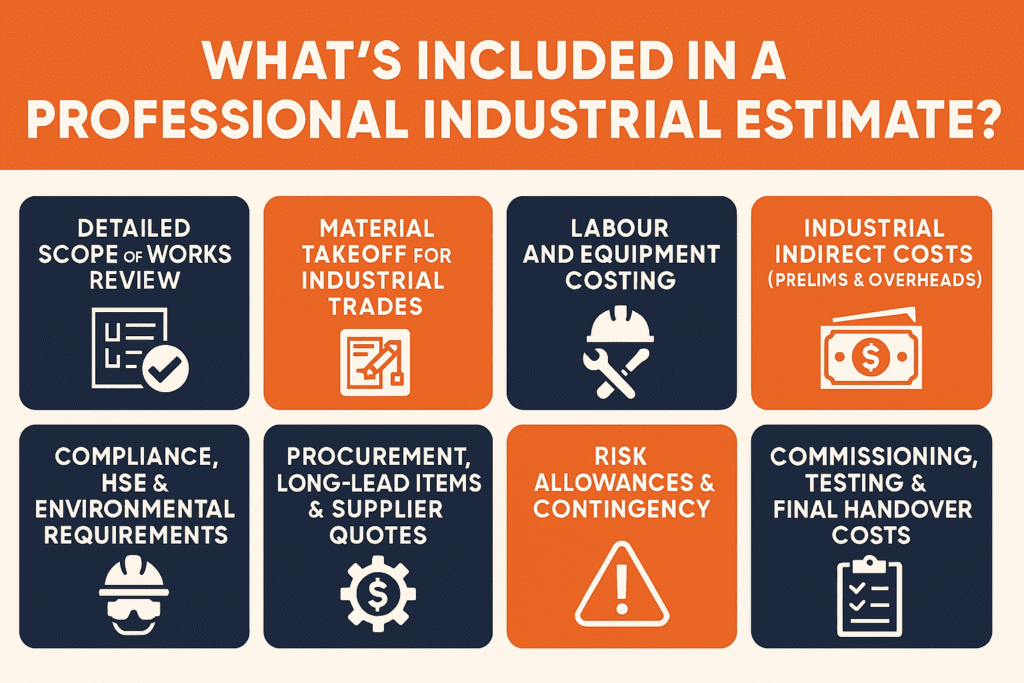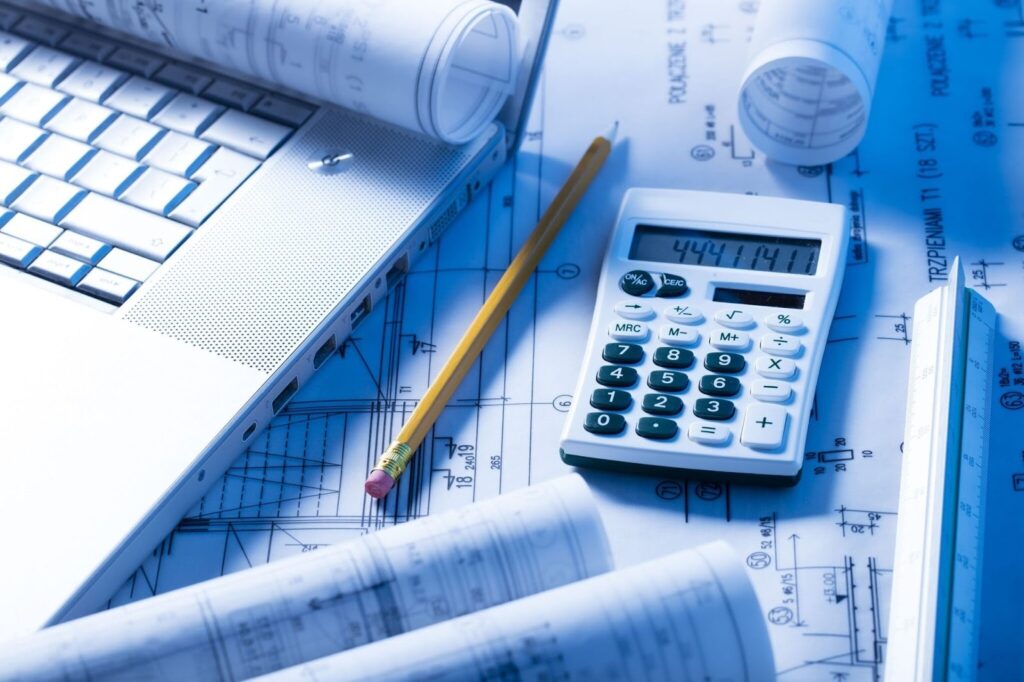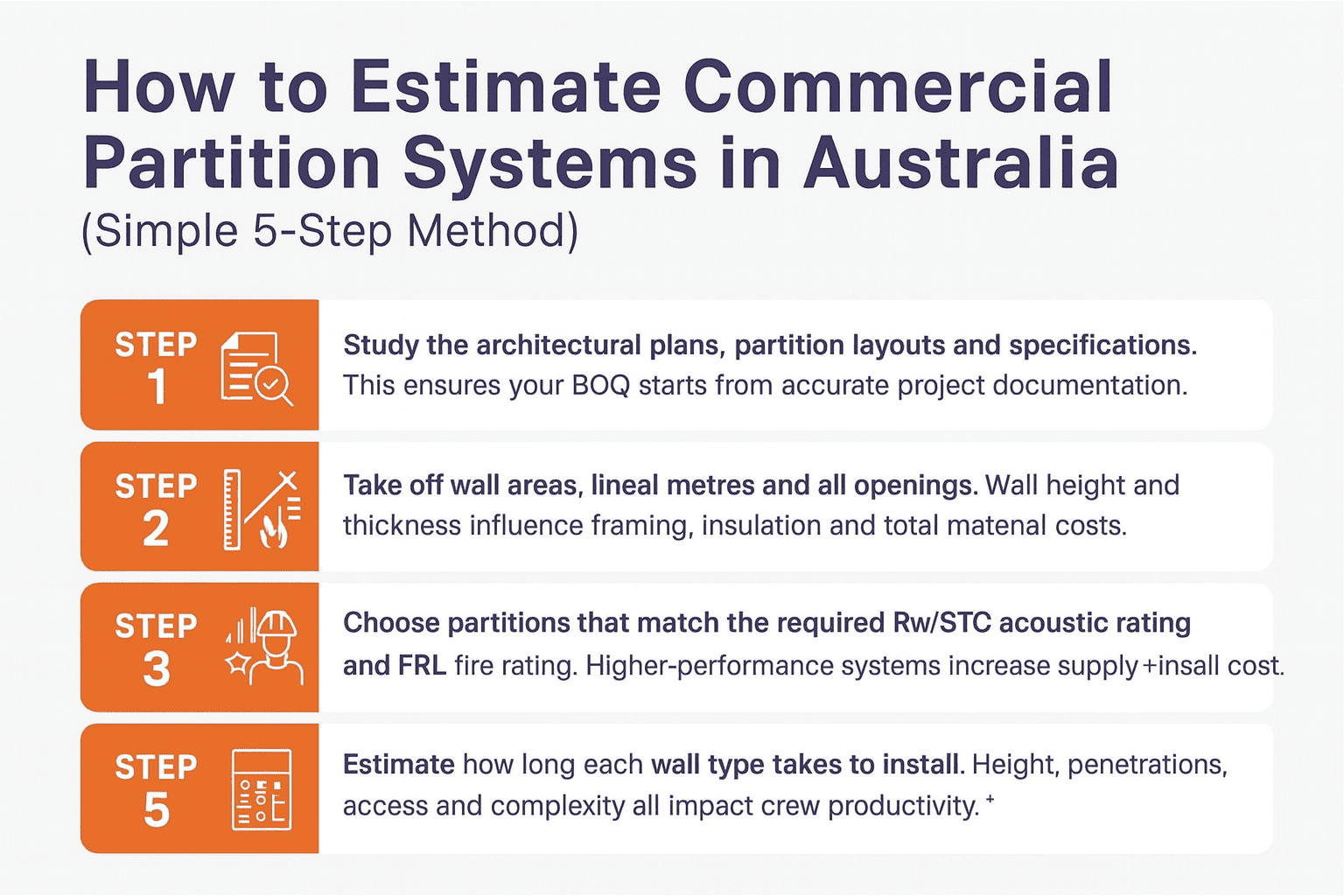A professional industrial estimate gives clients a clear view of what their project will cost and how the work will unfold. It breaks the job into understandable parts, removes guesswork, and supports accurate budgeting from day one. This clarity helps owners plan with confidence and avoid unexpected costs later.
A strong industrial estimate explains what an industrial estimate includes, outlines the detailed scope of works, and presents an easy-to-follow industrial cost breakdown. By organising every element into measurable industrial estimate components, the estimator provides a reliable foundation for decision-making, tendering, and overall project planning.

Detailed Scope of Works Review
A detailed scope of work review is the first step in creating a reliable industrial estimate. It ensures every drawing, note, and specification is understood before any numbers are calculated. This early clarity removes guesswork and sets the foundation for accurate costing and a smooth tender submission.
Estimators carefully examine IFC drawings, confirm inclusions and exclusions, and define work boundaries so nothing is overlooked. This industrial scope analysis is what keeps the entire construction cost estimate aligned with real site conditions and project requirements.
What This Review Covers:
- IFC Drawing Check: Reviewing final construction drawings to confirm dimensions and technical details.
- Specification Matching: Ensuring materials and standards follow the project’s written specifications.
- Inclusions List: Identifying all items that must be priced within the detailed scope of works for industrial projects.
- Exclusions Clarified: Listing items outside the estimator’s responsibility to avoid disputes later.
- Work Boundary Mapping: Defining clear limits for each trade to support precise scope review estimating.
- Tender Alignment: Making sure scope documents match what will be submitted in the final tender package.
Material Takeoff for Industrial Trades
Material takeoff for industrial trades is the backbone of any accurate estimate. It involves breaking the project into clear, measurable components and calculating the exact quantities needed for construction. This step removes assumptions and ensures every trade is priced based on real numbers rather than rough guesses.
Each subsection focuses on a different trade to keep the process clean and organised. By separating structural, mechanical, piping, electrical, and HVAC elements, the estimator creates a MECE-based breakdown that supports clearer costing and a dependable final estimate.
Structural Elements
Structural material takeoff covers all the core components that hold an industrial facility together. The estimator measures steel tonnage, checks fabrication details, and calculates surface areas for coating. Concrete volumes for slabs, pits, and industrial foundations are also confirmed. This structural steel estimate and concrete works estimate form the first layer of accurate pricing. Whether it’s a steel takeoff for industrial fabrication or concrete estimating for foundations, each quantity is extracted directly from the IFC drawings to avoid errors and unexpected costs later.
Mechanical Equipment & Installation
Mechanical equipment estimating focuses on the major systems that keep an industrial plant running. Pumps, compressors, tanks, and specialised machinery are measured based on size, quantity, and installation requirements. The estimator reviews fabrication needs, lifting considerations, and alignment details. This mechanical equipment estimate ties directly into mechanical and electrical estimating, ensuring both supply and installation costs are captured correctly. It offers a full picture of what’s required to assemble and commission mechanical systems on-site.
Piping & Process Systems
Piping quantity extraction is guided by P&IDs, making accuracy essential. The estimator calculates pipe lengths, counts valves and fittings, and identifies all supports required for installation. Since process piping plays a major role in industrial facilities, this step ensures the industrial piping estimate reflects the real layout and complexity of each line. From small-bore connections to large process mains, every measurement feeds into the final process piping cost estimate and prevents cost overruns during fabrication or installation.
Electrical & Instrumentation Works
Electrical and instrumentation takeoff covers everything from cable lengths to panel schedules. The estimator measures cable tray runs, checks termination points, and accounts for distribution boards and control systems. Because electrical systems link directly to plant operations, accuracy is critical. This breakdown supports industrial electrical estimating and ensures commissioning, testing, and control integration are correctly priced. It also helps avoid missing connections that often lead to variations later in the project.
HVAC & Ventilation Systems
HVAC material takeoff determines the quantities of fans, ducts, and exhaust systems needed to maintain airflow in an industrial environment. The estimator measures duct lengths, identifies equipment sizes, and reviews installation details for ventilation systems. This industrial facility ventilation estimate ensures the HVAC system is scaled correctly for the building’s function. Industrial HVAC estimating is especially important in facilities with heat-producing equipment or sensitive manufacturing processes, making accuracy essential for safety and performance.
Labour and Equipment Costing
Labour and equipment costing brings the estimate closer to real site conditions. It focuses on how many hours each task will take and what machinery is needed to complete the work safely and efficiently. By analysing crew setups, installation difficulty, and equipment hire pricing, the estimator creates a cost profile grounded in actual productivity.
This step ensures that labour requirements match the project’s pace and that cranes, lifts, or specialised machines are allocated for the right duration. It brings clarity to industrial labour rates and gives clients a realistic picture of labour and equipment pricing for industrial jobs.
What This Costing Covers:
- Labour Hours Assessment: Estimating the time each trade needs to deliver the required scope.
- Crew Composition Review: Matching the right mix of skilled workers to each activity.
- Equipment Hire Requirements: Identifying cranes, lifts, or machinery needed for installation.
- Equipment Duration Planning: Calculating how long machines must remain on-site to complete tasks.
- Productivity Rate Analysis: Adjusting labour hours based on task complexity and site conditions.
- Cost Integration: Combining labour and equipment costs into a single clear project allowance.
Industrial Indirect Costs (Prelims & Overheads)
Industrial indirect costs cover the essential activities that support construction but don’t appear as physical materials or installations. These items keep the site running safely and efficiently. By including preliminaries and overheads, the estimate reflects the true cost of delivering the project—not just building it.
This part of the estimate accounts for supervision, site setup, temporary facilities, and safety measures. Without these allowances, industrial projects face delays, cost overruns, and compliance issues. Clear coverage of direct and indirect costs in industrial estimating builds a more reliable and transparent budget.
What These Costs Include:
- Site Establishment: Setting up access, fencing, storage, and initial temporary works.
- Supervision & Management: Allowances for on-site leadership and project coordination.
- Temporary Facilities: Offices, amenities, lighting, power, and essential site services.
- Safety Measures: PPE, signage, inductions, and compliance requirements.
- General Overheads: Insurance, administration, and other overhead costs for industrial projects.
- Daily Operating Needs: Fuel, utilities, and ongoing services that keep the site functional.

Compliance, HSE & Environmental Requirements
Compliance, HSE, and environmental requirements are a core part of any professional industrial estimate. These costs ensure the project meets regulatory standards, keeps workers safe, and protects the surrounding environment. Including them upfront prevents delays, penalty risks, and unexpected expenses once work begins.
This stage of the estimate covers everything from permits and PPE to safety documentation and environmental controls. By addressing these industrial HSE cost factors early, the estimator creates a clear and realistic allowance for safety compliance costs industrial projects depend on.
What This Section Covers:
- Regulatory Permits: Allowances for approvals, certifications, and mandatory inspections.
- Safety Documentation: Site-specific safety plans, inductions, and compliance paperwork.
- Personal Protective Equipment: Required PPE for all workers on-site.
- Environmental Management: Measures for waste handling, spill control, and emissions.
- Monitoring & Reporting: Costs for ongoing safety and environmental tracking during construction.
- Compliance Administration: Time and resources needed to manage regulatory obligations.
Procurement, Long-Lead Items & Supplier Quotes
Procurement and long-lead items play a major role in shaping the accuracy of an industrial estimate. These components often involve imported equipment, specialised machinery, or materials that require extended delivery times. Including their true cost early helps avoid delays and unexpected budget shifts once construction begins.
In this part of the estimate, the estimator reviews vendor quotations, freight charges, and procurement planning requirements. By accounting for industrial procurement and equipment costing upfront, the estimate reflects the real timeline and financial impact of long lead items industrial projects rely on.
What This Section Includes:
- Vendor Quotations: Pricing from approved suppliers for major equipment and materials.
- Imported Equipment Costs: Duties, currency adjustments, and international supply factors.
- Freight & Logistics: Transport, handling, and delivery expenses for heavy or oversized items.
- Procurement Planning: Time and coordination required to secure long-lead assets.
- Lead Time Scheduling: Aligning expected delivery dates with project milestones.
- Risk Allowances: Buffers for potential delays or supplier-related uncertainty.
Risk Allowances & Contingency
Risk allowances and contingency help protect the project from uncertainties that can affect cost and schedule. These provisions account for unknown site conditions, technical challenges, and price escalation that may arise during construction. Including them ensures the estimate is realistic rather than optimistic.
In this stage, the estimator reviews potential risks and applies a fair, transparent allowance that reflects project complexity. This cost allowance and contingency for industrial builds strengthens the accuracy of the estimate and supports dependable industrial contingency estimating.
What This Section Covers:
- Site Condition Unknowns: Allowances for hidden ground issues or unforeseen obstacles.
- Technical Complexity: Extra time or resources needed for challenging installations.
- Material Price Escalation: Protection against market fluctuations.
- Labour Cost Variations: Adjustments for potential rate increases or shortages.
- Design Development Changes: Flexibility for updates during final detailing.
- Schedule Risks: Time-related costs if delays impact labour or equipment usage.
Commissioning, Testing & Final Handover Costs
Commissioning, testing, and final handover costs cover the work required after construction is physically complete. These tasks ensure every system operates safely and as designed before the facility is turned over to the client. Including them in the estimate prevents last-minute surprises and keeps the project compliant and ready for use.
This stage involves system testing, calibration, and pre-start checks across all major trades. By preparing an industrial commissioning estimate upfront, the estimator accounts for time, labour, and specialist input needed to finalise the project. This creates a complete view of commissioning cost industrial facilities depend on for a smooth start-up.
What This Section Covers:
- System Testing: Verifying performance across mechanical, electrical, and control systems.
- Calibration Work: Adjusting instruments and equipment for accurate operation.
- Pre-Start Inspections: Ensuring all components are installed safely and correctly.
- Commissioning Labour: Specialist technicians required for system activation.
- Documentation & Certification: Manuals, test reports, and compliance records.
- Client Handover Process: Final walkthroughs, training, and operational guidance.
Final Estimate Deliverables Provided to the Client
The final estimate deliverables bring everything together into a clear package the client can understand and rely on. These documents outline the full cost structure, show how quantities were calculated, and explain the assumptions behind the numbers. This transparency helps clients make confident decisions before moving toward tender submission.
In this stage, the estimator prepares BOQs, cost summaries, and supporting notes that detail what is included—and what is not. These tender documents for industrial facilities ensure no ambiguity remains and provide a complete set of industrial BOQ deliverables aligned with the detailed scope of works.
What This Section Includes:
- Bill of Quantities (BOQ): A structured list of all measured items with quantities.
- Cost Summary Sheets: A clear breakdown of totals by trade and cost category.
- Assumptions List: Clarifying the conditions used in preparing the estimate.
- Exclusions & Boundaries: Outlining what falls outside the estimated scope.
- Supporting Notes: Details on methods, data sources, and estimating considerations.
- Tender-Ready Documents: A complete package aligned with the detailed scope of works for submission.
FAQs
An industrial estimate includes measured quantities, material takeoffs, labour and equipment costing, indirect costs, procurement pricing, risk allowances, and commissioning costs. It also comes with a BOQ, cost summaries, assumptions, and clear inclusions and exclusions so the client knows exactly what is being priced.
A detailed scope of works keeps the estimate accurate and prevents misunderstandings. It defines what needs to be built, what drawings were used, and where each trade’s responsibilities start and end. Without it, costs can shift later because key details were unclear at the start.
The estimator reviews IFC drawings and extracts exact quantities for steel, concrete, piping, mechanical equipment, electrical systems, and HVAC. This process is called a material takeoff, and it ensures every item is priced based on real measurements, not assumptions.
Industrial projects rely on specialised crews and heavy machinery like cranes, lifts, and rigging equipment. The estimator calculates labour hours based on task difficulty and pairs them with the right equipment hire durations. This approach keeps labour and equipment costs aligned with real-world productivity.
Indirect costs—such as supervision, temporary facilities, site setup, and safety—are essential for running the project safely and efficiently. They don’t show up as materials, but without them, the project cannot operate. Including them makes the estimate more complete and realistic.
Long-lead items are equipment or materials that need extra time to manufacture or ship, such as imported pumps, switchboards, or structural components. They affect both cost and scheduling. Estimators include vendor quotes, freight, and planning time to ensure the project starts and finishes on schedule.
Conclusion
A professional industrial estimate brings clarity to every stage of a project. By breaking down materials, labour, equipment, indirect costs, procurement needs, risks, and commissioning requirements, it gives clients a complete picture of what the job will truly take. This level of detail helps prevent budget surprises, supports better decision-making, and keeps the project aligned with real site conditions.
When an estimate includes clear quantities, transparent assumptions, and well-defined scope boundaries, it becomes more than just a cost sheet—it becomes a planning tool. With the right estimating approach, industrial builds stay predictable, organised, and financially controlled from the very beginning.


